Sigma S 150-600 mm f/5-6.3 DG OS HSM
3. Build quality and image stabilization
In the photo below the Sigma S 150–600 mm is positioned next to the Sigma A 1.4/35.
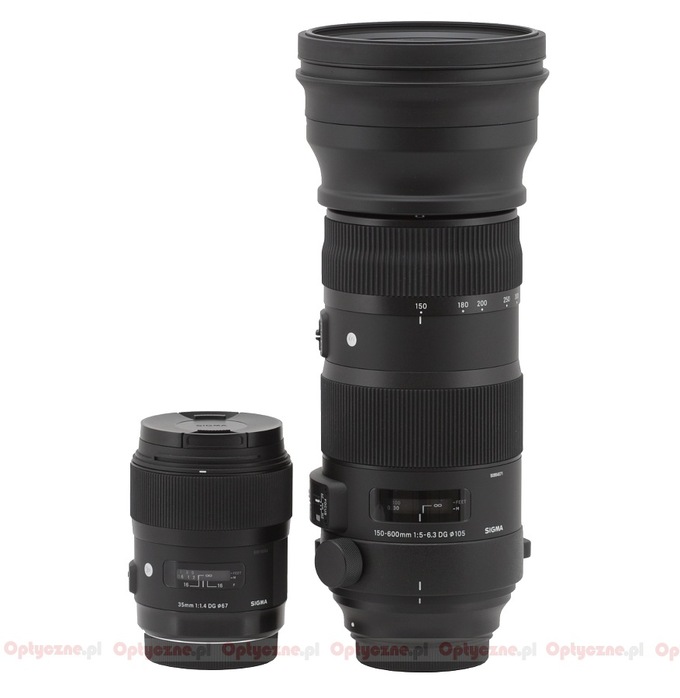 |
Please Support UsIf you enjoy our reviews and articles, and you want us to continue our work please, support our website by donating through PayPal. The funds are going to be used for paying our editorial team, renting servers, and equipping our testing studio; only that way we will be able to continue providing you interesting content for free. |
- - - - - - - - - - - - - - - - - - - - - - - - - - - - - - - - - - - - - - - - - - - - - - - -
The tested lens starts with a metal bayonet mount surrounding a plate with contacts and a tube, well-matted and ribbed. Inside that tube you can find a rear element of the lens, about 24 mm in diameter. It is hidden less than 2 cm deep when you set the focal length at 150 mm; after passing to 600 mm the element hides almost 6 cm deep, revealing more of the interior of the tube with a bit less perfectly darkened rails and a strip with electronics.
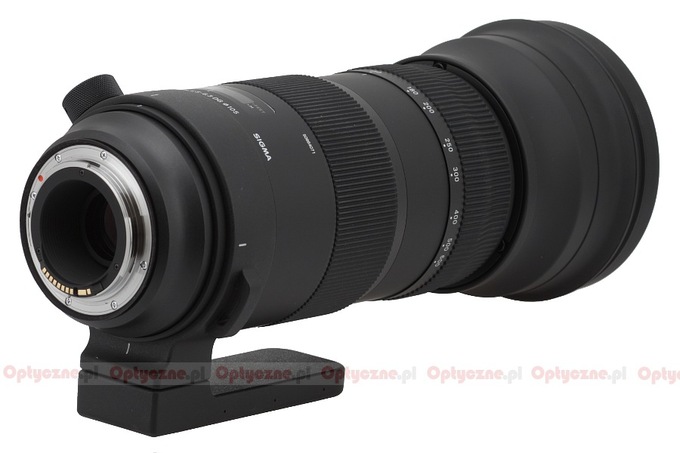 |
The proper tube of the lens is made of metal and it starts with a smooth ring with an increased diameter; on that ring you can find a white dot, making the alignment with a camera easier and a number, 014, marking the production year of the instrument.
The next part is a very solid tripod holder with a possibility of horizontal and vertical transition. Unfortunately it is permanently attached to the lens’s body and it’s a drawback – sometimes you have to walk with that type of lens quite a lot without carrying a tripod or a monopod with you. If you could take that holder off you would reduce the weight of the lens significantly and it would become handier.
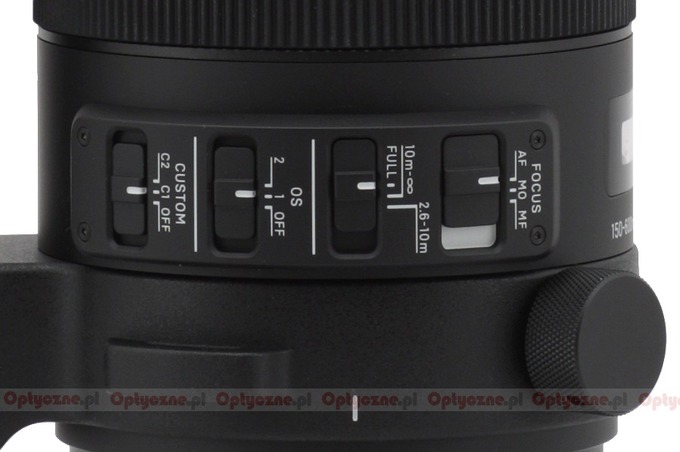 |
Moving along the tube you see an inscription with the name and the parameters of the lens and a distance scale window above it, with a scale expressed in feet and meters. On the left side there is a series of switches. The first of them, FOCUS, is used to control the focusing mechanism, with three possible positions: AF, MO and MF. Apart from the standard positions (when the lens is in the AF mode the manual focus ring still works), you also get the MO (Manual Override) option, allowing you to operate the ring even if the autofocus is in the continuous mode. The next switch limits the autofocus range, with three possible ranges: FULL, from 10 meters to infinity and from 2.6 meters to 10 meters.
Then you get an OS switch, controlling the optical stabilization unit (with 1, 2 and OFF modes) and as the last one, a switch labeled CUSTOM, which allows you to choose between three positions: OFF, C1 and C2. It is used to operate specific focusing mechanism modes, saved by the user after calibrating the lens by the Sigma USB Dock.
Further on you get a manual focus ring, 45 mm wide. It is ribbed, allowing you a firmer grip; its work is even and very precise. Running through the whole distance scale needs a turn through an angle of almost 180 degrees.
Behind it there is an immobile part of the casing with an “S” mark indicating that the lens belongs to the “Sport” line, and a LOCK switch, blocking the zoom position. What’s interesting, the lock works not only at both ends of the range but also at focal lengths which are marked on the casing. If a focal length is blocked and you want to release it you don’t have to reach that switch with your finger; it’s enough you move the zoom ring in a more decisive way and the switch will release the block – a very good solution, both clever and handy.
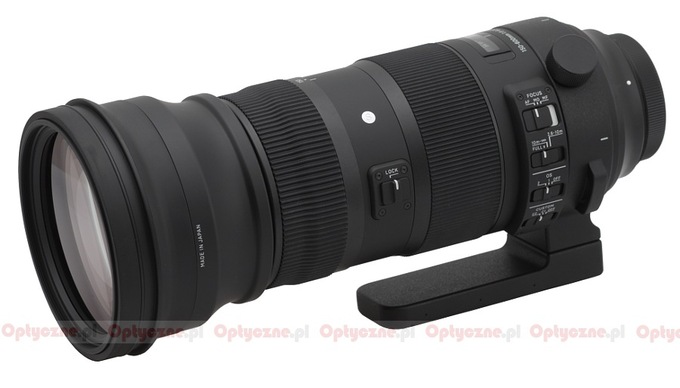 |
The next part is a zoom ring, 45 mm wide. Most of it is occupied by comfortable, rubberized ribbing and below you can find focal length markings at 150, 180, 200, 250, 300, 400, 500 and 600 mm.
The other, widened part of the lens features a front element system and an inscription “Made in Japan”. That part moves with the increase of the focal length, extending on a very solid, uniform tube.
The front element is 94 mm in diameter, just slightly hidden inside the casing, surrounded by a non-rotating filter thread, 105 mm in diameter. The lens doesn’t feature any typical hood mount because the hood is mounted to it with a special clamp.
It’s also worth mentioning that a special new material called TSC (Thermally Stable Composite) was used for some casing parts; it is characterized by a very low level of thermal shrinkage. What’s more, the lens is completely weather sealed, dust-proof and splash- proof; the outer glass elements are covered by hydrophobic layer that repels water and dirt easier.
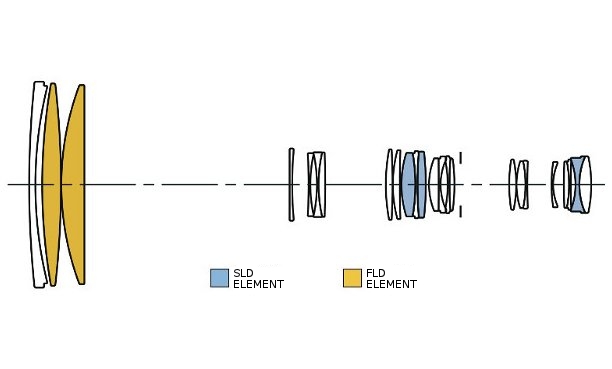 |
When it comes to the optical construction you deal here with 24 elements positioned in 16 groups. Two elements are made of FLD (Fluorite Low Dispersion) glass, with properties similar to those of fluorspar, and other three – of SLD (Special Low Dispersion) glass. Inside the lens uses a 9-blade circular aperture which can be closed down to f/29.
Buyers get a hard case, a hood with a cloth cover, a strap and a back cap in the box.
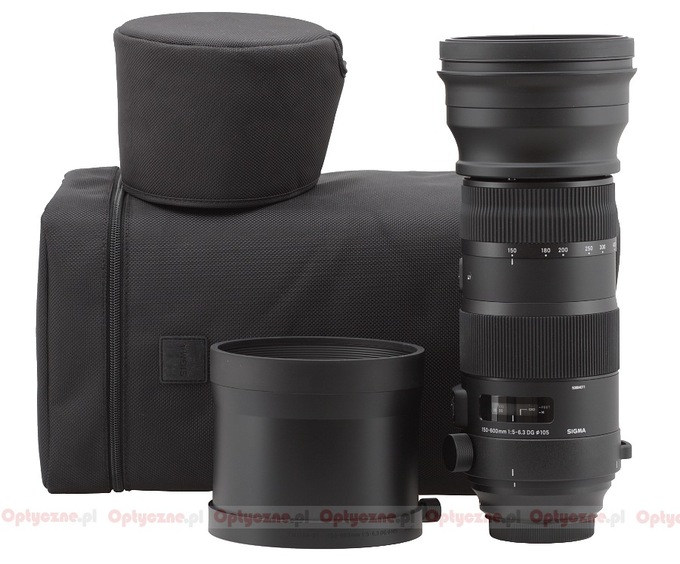 |
Optical stabilization
For some time now Sigma have stopped to provide optical stabilization efficiency results of their lenses. Of course it didn’t deter us from taking our own measurements. At 600 mm focal length we took several dozen of photos for every exposure time ranging from 1/640 to 1/10 of a second with the stabilization switched on and off. The graph below shows the percentage of blurred photos depending on the exposure time expressed in EV with 0 EV being an equivalent of 1/500 of a second.
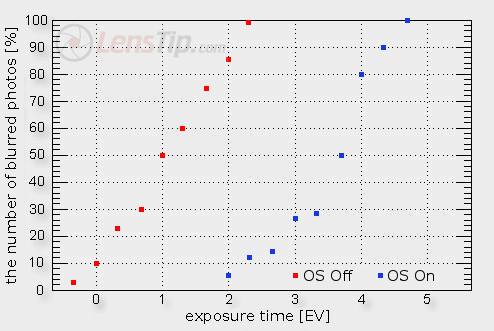
The result is a bit surprising because the maximum distance between both curves, indicating the stabilization efficiency, amounts to less than 3 EV. Such a value was characteristic for older Sigma lenses; the newer ones could get nearer 3.5 EV, the result shared by the rival Tamron 150-600 mm. Perhaps it is due to a combination of significant weight and big physical dimensions of the lens at 600 mm; anyway a small movement of your hand can make the front element system wobble and it is hard to stabilize the whole instrument.






